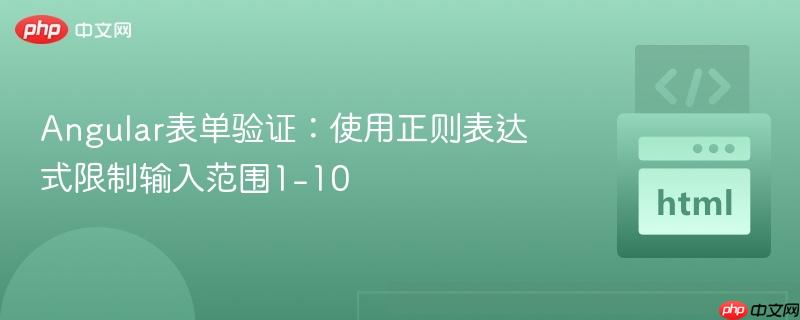
在进行表单验证时,限制数字输入范围是一个常见需求。然而,对于包含多位数的数字范围(例如1到10),简单的字符类(如[1-10])并不能满足要求。[1-10]只会匹配单个字符1到0(因为字符编码顺序),或者在某些情况下被错误理解为匹配1、0或\,它无法识别多位数字10。
例如,初学者常犯的错误包括:
要正确验证包含多位数的数字范围,我们需要将每个可能的数字或数字范围作为独立的模式,并使用逻辑或操作符连接起来。
针对1到10的数字范围,最精确且简洁的正则表达式是:
^([1-9]|10)$
这个正则表达式能够确保输入值要么是1到9之间的任意一个数字,要么是数字10,并且没有其他字符。
让我们逐一解析这个正则表达式的各个组成部分:
结合起来,^([1-9]|10)$确保了整个输入字符串必须完全匹配1到9之间的单个数字,或者完全匹配数字10。
在Angular应用中,我们可以将此正则表达式应用于模板驱动表单或响应式表单的pattern验证器。
在HTML模板中,可以直接使用pattern属性来应用正则表达式。
<form #heroForm="ngForm">
<div class="form-group">
<label for="valueInput">请输入1-10之间的数字:</label>
<input
type="text"
id="valueInput"
name="valueInput"
class="form-control"
[(ngModel)]="selectedValue"
pattern="^([1-9]|10)$"
#inputField="ngModel"
required
>
<div *ngIf="inputField.invalid && (inputField.dirty || inputField.touched)" class="alert alert-danger">
<div *ngIf="inputField.errors?.['required']">
此项为必填。
</div>
<div *ngIf="inputField.errors?.['pattern']">
请输入1到10之间的数字。
</div>
</div>
</div>
<button type="submit" [disabled]="heroForm.invalid" class="btn btn-primary">提交</button>
</form>在对应的组件(.ts文件)中:
import { Component } from '@angular/core';
@Component({
selector: 'app-number-input',
templateUrl: './number-input.component.html',
styleUrls: ['./number-input.component.css']
})
export class NumberInputComponent {
selectedValue: string = ''; // 初始值可以为空字符串
}解释:
对于响应式表单,可以使用Validators.pattern()方法。
在组件(.ts文件)中:
import { Component, OnInit } from '@angular/core';
import { FormBuilder, FormGroup, Validators } from '@angular/forms';
@Component({
selector: 'app-reactive-number-input',
templateUrl: './reactive-number-input.component.html',
styleUrls: ['./reactive-number-input.component.css']
})
export class ReactiveNumberInputComponent implements OnInit {
numberForm!: FormGroup;
constructor(private fb: FormBuilder) { }
ngOnInit(): void {
this.numberForm = this.fb.group({
valueInput: ['', [Validators.required, Validators.pattern('^([1-9]|10)$')]]
});
}
onSubmit(): void {
if (this.numberForm.valid) {
console.log('表单提交成功:', this.numberForm.value);
} else {
console.log('表单无效');
}
}
}在HTML模板中:
<form [formGroup]="numberForm" (ngSubmit)="onSubmit()">
<div class="form-group">
<label for="valueInputReactive">请输入1-10之间的数字:</label>
<input
type="text"
id="valueInputReactive"
formControlName="valueInput"
class="form-control"
>
<div *ngIf="numberForm.get('valueInput')?.invalid && (numberForm.get('valueInput')?.dirty || numberForm.get('valueInput')?.touched)" class="alert alert-danger">
<div *ngIf="numberForm.get('valueInput')?.errors?.['required']">
此项为必填。
</div>
<div *ngIf="numberForm.get('valueInput')?.errors?.['pattern']">
请输入1到10之间的数字。
</div>
</div>
</div>
<button type="submit" [disabled]="numberForm.invalid" class="btn btn-primary">提交</button>
</form>通过本教程,我们深入探讨了如何在Angular应用中,利用精确的正则表达式^([1-9]|10)$来验证用户输入是否在1到10的数字范围内。我们详细解析了该正则表达式的每个组成部分,并通过模板驱动表单和响应式表单的示例代码,展示了其在Angular中的具体应用。理解^和$锚定符的重要性,以及正确使用逻辑或操作符,是构建健壮表单验证的关键。在处理更复杂的验证场景时,也可以考虑结合自定义验证器,以实现更灵活的验证逻辑。
以上就是Angular表单验证:使用正则表达式限制输入范围1-10的详细内容,更多请关注php中文网其它相关文章!

每个人都需要一台速度更快、更稳定的 PC。随着时间的推移,垃圾文件、旧注册表数据和不必要的后台进程会占用资源并降低性能。幸运的是,许多工具可以让 Windows 保持平稳运行。

Copyright 2014-2025 https://www.php.cn/ All Rights Reserved | php.cn | 湘ICP备2023035733号